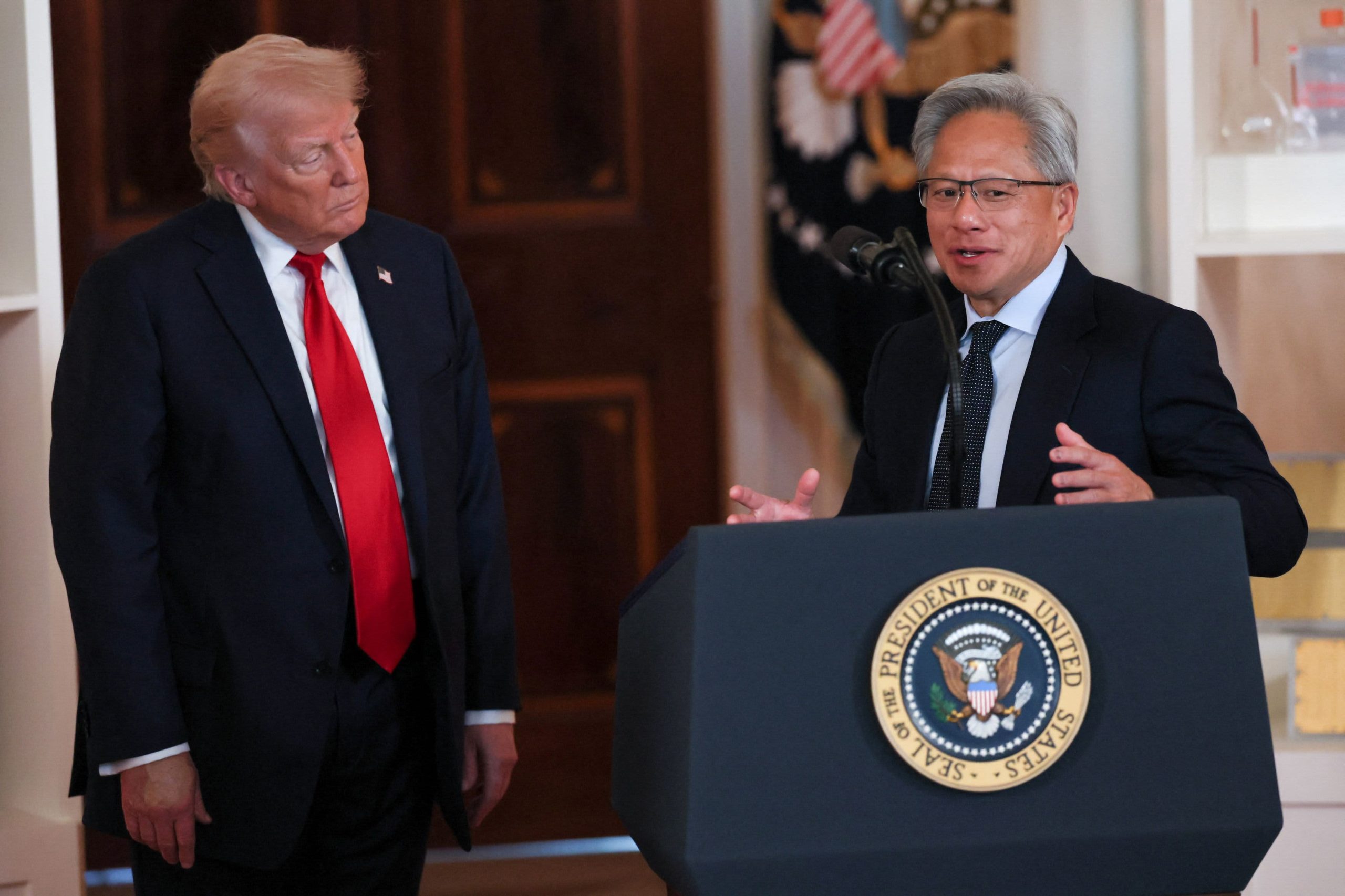After briefly considering a breakup of Nvidia, Trump backed off—just as CEO Jensen Huang sold $12.94M in stock and South Korea’s FuriosaAI entered the AI chip race.
In a rare moment of candor at this week’s AI Leadership Summit in Washington, Donald Trump admitted he once seriously considered breaking up Nvidia.
“I figured we could go in and we could sort of break them up a little bit,” Trump told the crowd, recalling early conversations with advisors. “And I found out it’s not easy in that business.”
The comment, delivered just feet from Nvidia CEO Jensen Huang, reflected a growing unease in political circles about one of the most powerful companies in the world. But Trump’s tone quickly shifted—from breakup talk to something more congratulatory: “What a job you’ve done,” he said, turning to Huang with a smile.
Just days before this exchange, Huang sold $12.94 million in Nvidia shares, according to SEC filings. And while the sale may have been scheduled under a 10b5-1 plan, the timing couldn’t be more telling. Nvidia has recently crossed the $4 trillion valuation mark, regulators are circling, and new rivals—like South Korea’s FuriosaAI—are beginning to challenge its dominance.
So the question isn’t just can Trump break up Nvidia? It’s also this: Does he even need to anymore?
A Rare Acknowledgment of Market Power
Trump’s public reflection is significant. For all the bluster that typically surrounds antitrust debates, rarely do politicians admit how difficult it is to regulate cutting-edge technology companies. Nvidia’s dominance in AI chips is profound—it supplies more than 80% of the high-performance GPUs that power AI models worldwide, from ChatGPT to Tesla’s neural nets.
That kind of control has historically triggered government scrutiny. But as Trump conceded, the AI chip sector is a different animal. “It’s not easy in that business,” he said, adding that advisors explained how deeply Nvidia’s dominance is tied to scale, innovation, and U.S. geopolitical interests.
Can the U.S. Government Break Up Nvidia?
Not directly. No president, including Trump, has unilateral power to break up a private company. But there is a legal pathway—albeit a long and complex one.
Under U.S. antitrust law, particularly Section 2 of the Sherman Antitrust Act and Section 7 of the Clayton Act, the Department of Justice (DOJ) or Federal Trade Commission (FTC) could bring a case alleging monopolization or anticompetitive mergers.
If a court agrees, it can impose structural remedies—including divestiture. But this requires significant legal groundwork, compelling evidence of harm to competition, and the political will to pursue it over several years.
As Trump indicated, that’s a steep hill to climb. And regulators may hesitate to fracture a company so central to America’s AI ambitions—especially as China accelerates its own semiconductor industry.
Why Jensen Huang’s Stock Sale Matters
Adding a layer of intrigue to the week’s events: Huang sold nearly $13 million worth of shares in July 2025. While executives frequently offload shares for liquidity or tax reasons, this sale—amid escalating political attention and Nvidia’s historic valuation—sparked questions.
Is Huang simply diversifying his personal holdings? Or is he hedging against future turbulence?
There’s no evidence of wrongdoing. But with antitrust conversations heating up and new competition emerging, even routine sales take on symbolic weight. They suggest Huang knows just how fast the AI landscape is shifting beneath his feet.
FuriosaAI: The Challenger From Seoul
In the same week that Trump floated antitrust action and Huang sold shares, a lesser-known figure was making waves on the other side of the Pacific: June Paik, founder and CEO of FuriosaAI.
Based in Seoul, FuriosaAI is developing a new generation of specialized AI processors focused on efficiency and inference performance. On July 22, 2025, the company landed its first major client: LG AI Research, which will deploy Furiosa’s flagship RNGD chip across several global projects.
The timing wasn’t the only surprise. According to sources familiar with the matter, Meta Platforms recently offered $800 million to acquire FuriosaAI—an offer Paik reportedly turned down.
That bold rejection sent a clear message: Furiosa isn’t looking for a buyout. It wants to compete. And suddenly, Nvidia’s monopoly doesn’t look quite as inevitable.
Is Nvidia Still a Monopoly If New Players Are Rising?
This question may define future regulatory action. Nvidia’s critics argue the company has “locked in” AI developers through its proprietary CUDA software stack, creating high switching costs for rivals. Others counter that emerging competition like FuriosaAI or AMD’s MI300 series proves that Nvidia’s dominance, while enormous, is not unchallengeable.
Legally, that distinction matters. Courts are more likely to view a company as a monopoly if there’s no meaningful alternative. But with Furiosa’s LG win and growing investment in open-source AI frameworks, the case against Nvidia may be harder to make.
Still, there’s little doubt about Nvidia’s current influence. Its chips don’t just power generative AI—they shape who can build it, how fast it can grow, and what the global pecking order looks like.
Trump’s True Direction: Deregulate, Not Dismantle
While Trump’s remarks drew attention, his actual policy moves this week went in the opposite direction. He unveiled a new AI Action Plan, along with executive orders aimed at streamlining federal approval for AI development and export.
Shortly before the summit, the administration gave Nvidia the green light to resume H20 chip sales to China, softening earlier export restrictions. Trump’s message to American tech firms was clear: innovate, lead, and grow—without bureaucratic friction.
Jensen Huang, speaking just before Trump, appeared to welcome that approach. He called Trump “a unique advantage America holds” over competitors like China and the EU.
In that context, the idea of breaking up Nvidia feels more like political theater than a practical roadmap.
Final Take: Trump Can’t Break Up Nvidia—But the Market Might
Trump may not have the tools—or the appetite—to break up Nvidia. But his comments signal a critical turning point: Nvidia is no longer just a tech company. It is national infrastructure, foreign policy leverage, and a lightning rod for the risks of concentrated power.
And while regulators debate what to do, market forces are already at work. FuriosaAI’s rise, LG’s alignment with Seoul, and Huang’s quiet cash-out all suggest a new chapter is beginning.
In the race to power the world’s next generation of artificial intelligence, Nvidia is still out front—but the road behind it is no longer empty.
Nvidia Break Up FAQ's
Can Trump legally break up Nvidia?
No. Only the DOJ or FTC can initiate antitrust proceedings, and any breakup would need to be approved by a federal court.
Why did Jensen Huang sell Nvidia shares?
Huang sold $12.94 million worth of Nvidia stock in July 2025. While common among executives, the timing raised questions given Nvidia’s dominant position and rising scrutiny.
What is FuriosaAI, and why does it matter?
FuriosaAI is a South Korean chipmaker led by June Paik. It recently landed LG as a client and turned down an $800M Meta acquisition, positioning itself as a serious Nvidia competitor.
Is Nvidia a monopoly?
Nvidia holds a dominant share of the AI GPU market and key software tools. While not legally declared a monopoly, it is under increased global regulatory scrutiny.
What is Trump’s AI policy?
Trump’s AI Action Plan aims to deregulate and accelerate AI development in the U.S., favoring growth over antitrust enforcement.














